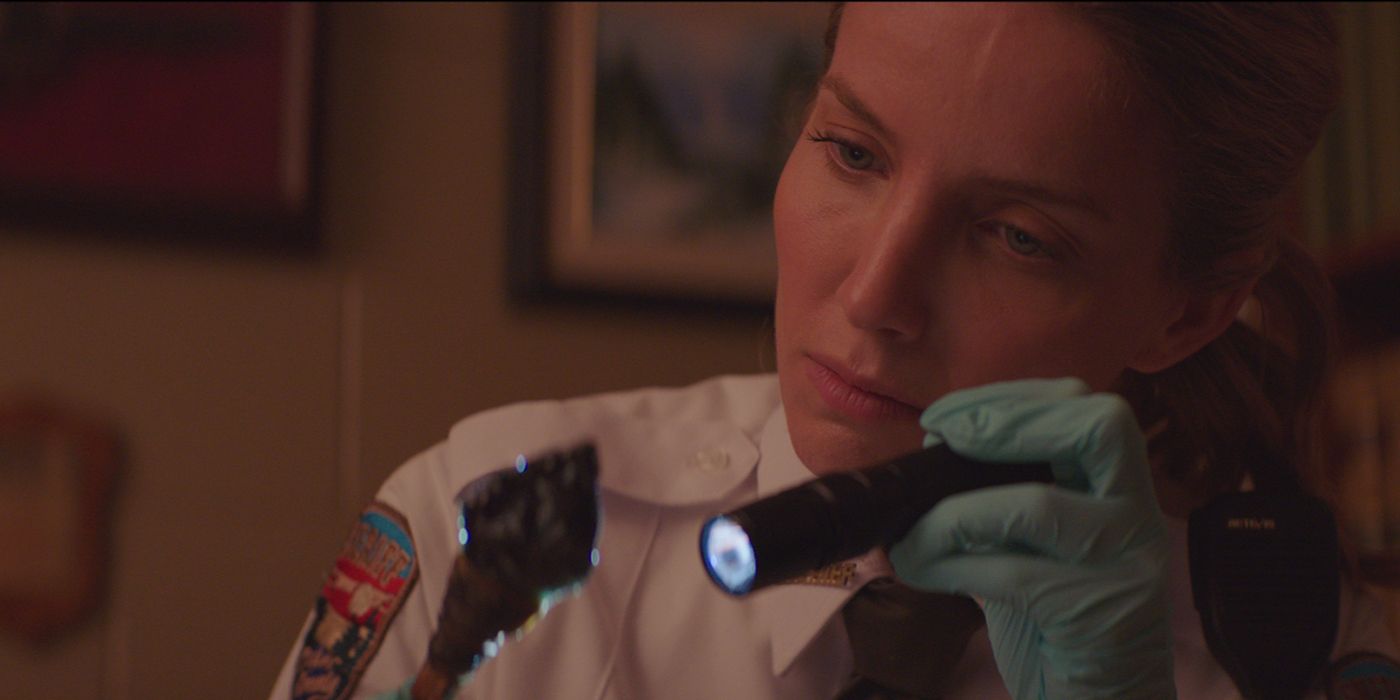This article contains discussions of alcohol use disorder and child abuse. It also contains spoilers for The Silencing.
The 2020 action-thriller movie The Silencing incorporates a traditional storyline, but its ending packs a few punches. The Silencing follows Rayburn Swanson, a reformed hunter with an alcohol-use disorder, whose daughter Gwen went missing five years earlier. When a body washes up on a lake shore, Rayburn meets up with Sheriff Alice Gustafson to identify the body. After determining the body isn’t Gwen’s, the sheriff makes it her mission to identify the victim and killer. The only clue to the killer’s identity is a spearhead with the initials “M.B.” carved in it.
Back in Rayburn’s animal sanctuary, the former hunter sees a man in a ghillie suit chasing a woman named Molly through the woods. Rayburn saves Molly from the killer, giving her shelter in an unused spike trap. When they make it back to the cabin, the killer attacks them again. Alice shows up and sees a specific behavior that makes her believe the killer is her brother, Brooks. To protect her brother, she shoots Rayburn and calls for his arrest. When he escapes, a local doctor helps treat his wounds. The Silencing's decent action-thriller plot leads to an intense ending filled with compelling action sequences and a massive plot twist.
Who Is The Silencing's Killer? Identity And Motive Explained
Doctor Boone Is The Violent Culprit

Though Rayburn and Alice have suspects, the killer’s identity remains a mystery throughout The Silencing until the very end. The killer is none other than Doctor Boone, a doctor who treated Rayburn’s gunshot wound earlier in the movie. This reveal comes across as rushed and confusing because Boone has minimal time onscreen before his unmasking. The other suspects at least had reasons established earlier in the film as to why they might commit heinous murders. There’s little to no foreshadowing or logic behind Doctor Boone's reveal in The Silencing.
Doctor Boone’s motives in The Silencing make even less sense than his identity. Years earlier, the doctor’s daughter, Melissa, gets killed in a drunk-driving hit-and-run. This completely wrecks his mental state. In the midst of his grief, he decides to start kidnapping and murdering teenage girls to save them from parents who wouldn’t miss them. Doctor Boone kidnapping teenage girls like his daughter tracks with his line of thinking. He doesn’t want them to face the same negative consequences his daughter did. What doesn’t make sense is why he would murder them. He’s essentially committing the same act as the person who killed his daughter.

Related
Annabelle Wallis Interview: The Silencing
The Silencing star Annabelle Wallis chats about playing an antihero in the film, available now, and hints at a return to Peaky Blinders.
What Happened To Rayburn’s Daughter?
Boone Abducted The Child

Rayburn is the central protagonist of The Silencing, and his daughter’s disappearance is his driving motivator. When he sees Molly running from Doctor Boone in a ghillie suit, he puts his safety at risk seemingly because she reminds him of his daughter. Rayburn doesn’t learn what actually happened to Gwen until he unmasks Doctor Boone, though. Boone reveals that he took Gwen because of Rayburn’s alcohol use disorder.
When the doctor looks at Rayburn, he sees a failure and a waste of space, a common societal perception of people with any kind of substance-use disorder. When Doctor Boone took Gwen, he figured that the dad was just like the person who killed his daughter because of Rayburn’s mental disease. In his mind, Rayburn didn’t deserve to have Gwen. Boone also blatantly states that he believed Rayburn would raise Gwen to be as “useless” as her dad.
Unfortunately, this mentality purported by Doctor Boone, Rayburn’s ex-wife, The Silencing’s ending entirely disregards the facts about alcohol use disorder. People with alcohol use disorder have a disease that affects their cognitive functions like reasoning and impulse control. Their illness isn’t a character defect. Ultimately, the only thing saving The Silencing from completely demonizing people with this illness is the fact that the primary person saying these things is a kidnapper and murderer.
Why Does Rayburn Stop Hunting?
Memories Of His Daughter Changed His Worldview

Before the events of The Silencing, Rayburn quits hunting and starts an animal sanctuary. This seems like a drastic change from one end of the spectrum to the other. Rayburn's only explanation comes when he’s speaking to the kids visiting his sanctuary. He tells them that he stopped hunting because “My daughter didn’t like it.” However, the middle and end of The Silencing reveal details that provide a fuller picture of why he stopped.
Rayburn was telling the truth that his daughter didn’t like it, but he seemingly didn’t change his behavior until after she went missing. He might have made the decision to honor her memory, signaled by the fact that the sanctuary is named after her. However, he was also undoubtedly influenced by the guilt he felt about his daughter going missing while he was buying alcohol.

Related
10 Highly-Rated Thriller Movies With Underwhelming Endings, Ranked Best To Worst
Any good Hollywood thriller can hook the audience, but a great one haunts with a killer ending. Films like The Invisible Man and Joker didn't deliver.
The Significance Of The Barn In The Silencing
Alice's Guilt Is Triggered By The Building
When Alice drives Brooks to his apartment at the start of The Silencing, he starts asking her to go a different way. She doesn’t listen, and he starts panicking when he sees a barn. Alice later states she should have adopted him after their parents died. The meaning of these scenes finally becomes clear in a small moment a little over halfway through the film. Alice goes to talk to Brooks and finds two newspaper clippings in his empty apartment. The headlines read, “Foster parents charged in horrific child abuse case” and “Teenage boy kept locked in barn.”
By combining this information with the previous scenes, it becomes clear that Alice feels guilty that she left her brother in a situation where he was horrifically abused. The barn remains a symbol of the secondhand trauma that she hasn’t reconciled with. It’s also where Brooks goes to commit acts of violence, symbolizing the cycle of abuse. This makes it one of the most significant filming locations in The Silencing.

Related
Best Psychological Thriller Movies On Netflix
The best psychological movies on Netflix offer everything from classics and Netflix originals to award winners and international releases.
The True Meaning Of The Silencing’s Ending
Themes Of Trauma And Closure Are The Focus

At the end of The Silencing, Rayburn pushes Doctor Boone into an animal trap, rather than letting Alice arrest the murderer. Afterward, he takes down the missing signs, attends Gwen’s funeral, and gets rid of his alcohol. Meanwhile, Alice watches as an excavator tears down the barn. These last few scenes send the movie’s true, albeit misguided, message.
The Silencing tells viewers that closure allows people to heal from trauma. While this is a lovely sentiment at face value, it vastly misconstrues the long-term impact of severe trauma. Healing from trauma takes significantly more work than what’s shown. Moreover, recovery from alcohol use disorder requires more than just throwing away alcohol. Despite these discrepancies, The Silencing’s ending offers hope in a world that’s so often hopeless, making its message valuable.
How The Silencing Ending Was Received
Critics Were Less Than Thrilled With The 2020 Movie From Start To Finish

Robin Pront's 2020 action thriller wasn't received too well by critics, though The Silencing ending isn't to blame. Rather, it's the overall pace and tone of the movie that seems to have led to the lukewarm response. The climax didn't break or diminish the overall story. Instead, the issue is that the story itself (according to many critics) wasn't developed enough by the time the ending actually arrived. There were also some complaints that the plot of The Silencing was too predictable.
For example, critic Glenn Kenny writing for rogerebert.com dedicated most of his review of The Silencing to pointing out the lack of originality. Summing up both his own views and those echoed by several other critics, Kenny explains his issue with the 2020 thriller rather scathingly:
So predictable; add in dialogue like, "Out here that badge don't mean s**t, lady," and you start wondering if this movie's going to put ANYTHING new on the table. I mean, Pront shoots and stages all this stuff with slick facility, and the Dane and the two English actors really put their back into playing gruff rural ‘Muricans, or maybe Canadians (things never come off as all that specific), but one does feel one's seen all this before.
While Kenny doesn't mention the final moments specifically, the fact that he didn't single it out as a positive shows that The Silencing ending is included in his critique. He did point out a few positives, such as the cinematography of director Robin Pront, so if the ending of The Silencing did redeem an otherwise lackluster story, it would have been pointed out. Kenny's review isn't alone either, as many critics also shared the same sentiments.
A more balanced appraisal that still has issues with the pacing of the ending of The Silencing comes from reviewer The Iceman on joblo.com. While this review is more forgiving than Kenny's and many others, The Iceman still points out that the story didn't feel ready for a conclusion by the time the ending of The Silencing arrived:
What could have been stretched out into a miniseries ends up being awkwardly crammed into the standard feature-length. Because of story cramming, we get people showing up out of nowhere (time is very flimsy here), not calling for back-up EVER and flesh wounds that seem to heal overnight (we get a limp for two scenes that should have lasted months). I feel like this sprints to the finish line, and it ends up mudding up a great idea with clichés and generic character actions that would be better suited on a CBS drama.
Ultimately, the ending of The Silencing wasn't strong enough to win over critics, as evidenced by its 20% Tomatometer score on Rotten Tomatoes. It wasn't universally panned, but the 2020 thriller is far from an acclaimed title. However, it did go down much better with audiences (as the 90% Popcornmeter audience ranking also shows). It seems that Robert Pront's The Silencing is another example of a movie that highlights the different tastes of critics and general audiences. While critics were put off by the by-the-numbers storytelling and cliche-heavy movie, many viewers found the familiarity made the gritty thriller a thoroughly enjoyable watch.

The Silencing is a thriller film that follows a reformed hunter, played by Nikolaj Coster-Waldau, who is drawn into a deadly game of cat and mouse when a young girl is abducted. Directed by Robin Pront, the story unravels in a remote wildlife sanctuary and involves the hunter teaming up with a local sheriff, portrayed by Annabelle Wallis, to track down the killer.
Director Robin Pront
Release Date July 18, 2020
Runtime 93 Minutes









 English (US) ·
English (US) ·